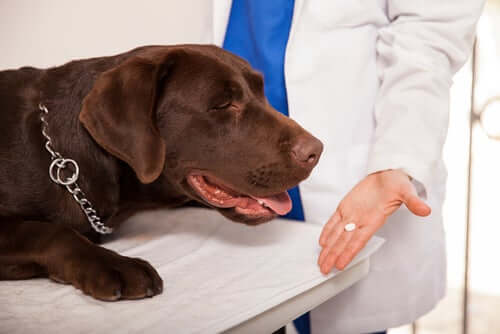Important Information Regarding Hemophilia in Dogs


Written and verified by the lawyer Francisco María García
Hemophilia in dogs is a disease that has to do with blood and is hereditary in nature. It requires a great deal of care, given the risks and dangers it involves and tends to appear after a dog has reached 2 months of age.
Hemophilia consists of a disorder with blood clotting; it inhibits the enzymes and proteins that thicken the blood. As a result, the blood that circulates in the animal’s body is very liquid.
The best way to treat hemophilia in dogs is with the help of a specialist. The owner of the animals should pay careful attention to any irregularity of a circulatory nature and seek veterinary attention right away.
How does hemophilia in dogs manifest itself?
Unfortunately, there’s no way to make a prior diagnosis unless owners are aware of the medical history of the dog’s parents. This illness can have serious consequences, from constant bleeding to hemorrhaging.

It’s important to point out that hemophilia is a hereditary disease. Unfortunately, this means that the mother passes the disease onto her pups through a deficiency in the X chromosome.
As for male dogs, they will always suffer from this illness if they inherit the chromosome from their mother. However, as for females, they will only be carriers unless both the mother and father are carriers of the chromosome.
There are certain canine breeds that are more likely to suffer hemophilia than others. For example, both German Shepherds and Dobermans have a greater chance of inheriting this disease.
The most common time to find out that an animal has hemophilia is after an injury. In general, under normal conditions, coagulation takes place immediately, thus preventing prolonged bleeding. However, in the case of hemophilia in dogs, the bleeding never lets up.
If the injury is a simple superficial cut, then the risk isn’t great. However, when it comes to deeper or more serious lesions, hemophilia can be deadly.
What to do if you suspect hemophilia in dogs
If your dog has had an episode of prolonged bleeding, then the best thing you can do is seek immediate veterinary attention. Depending on the origin and location of the injury, the specialist will determine the body’s means of reaction. In other words, the professional will determine if an anomaly in the circulatory system exists.
There are three types of hemophilia: A, B, and C, otherwise known as mild, moderate, or severe. In the case of mild or type A hemophilia, it’s usually only detected when there’s an injury. At the same time, types B and C (moderate or severe hemophilia) usually appear between 4 and 6 months of age.
In these cases, it’s common for dogs to experience bleeding in their noses or gums. What’s more, there may also be blood present in their urine or feces.
How to treat hemophilia in dogs
- The first thing you must do is get a diagnosis. Unless the owner knows that the animal is hemophiliac, a veterinarian must determine the cause of bleeding.
- In some cases, constant bleeding can be the result of external factors. A common cause is the ingestion of rat poison by the dog, as well as being bitten by a cobra.
- In both circumstances and, the poison in the dog’s system inhibits the enzymes that clot the animal’s blood.

- Also, a deficiency in the absorption of vitamin K can cause uncontrolled bleeding. This is due to the fact that vitamin K acts upon the liver, the organ that’s responsible for producing clotting enzymes.
- Some medications can also affect the blood thickening process. For example, the prolonged use of antibiotics. An overdose can also occur in the case of dogs that consume anticoagulants.
- If your veterinarian diagnoses your dog with hemophilia, they will likely prescribe coagulants. If not, they may apply treatment based on vitamin K.
- Recent studies have determined a type of gene therapy for overcoming hemophilia. The therapy consists of injecting the animal with factor VIII, the cause of the illness.
- Up to this moment, animals that have undergone this type of therapy have been free of hemophilia for three years.
- Early sterilization of animals can prevent hemophilia in dogs, as well as other diseases.
Considerations regarding circulatory disorders
The lack of coagulation in the blood can lead to other health problems for animals. The most common is anemia, which results from an internal hemorrhage.
The symptoms of this condition are weakness, breathing problems, and arrhythmias. The animal may also appear confused and lethargic. What’s more, hemophilia in dogs can cause vomiting and bloody stools.
This text is provided for informational purposes only and does not replace consultation with a professional. If in doubt, consult your specialist.